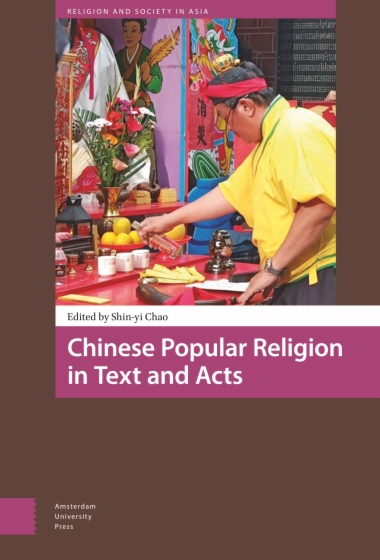This volume explores practices and experiences in Chinese popular religion. The research adds new materials and new approaches to well-known worships such as the cults of doomsday, underworld, and Lord Guan on the one hand, and draws attention to under-the-radar deities and holy figures hiding in the mountainous countryside or among the urban crowd. While this book centers on Chinese popular religion, it will be of use to non-China scholars in folklore, religious art, and ritual studies as well as China scholars in popular culture from late-medieval to contemporary times.
- Cover
- Table of Contents
- Acknowledgements
- Introduction
- Text, Acts, and Traditionalization: Performing Chinese Popular Religion
- Section One Texts And Acts
- 1 Confluence of Fears: The 1923 Doomsday Hysteria in China
- 2 Temple Inscriptions as “Text Acts”
- Section Two Scriptures and Rituals
- 3 Shuilu Rites and the Baodingshan Rock Carvings of Dazu
- 4 The Worship of the Ten Kings of Purgatory during the Ming-Qing Period
- 5 Feasting with the Great-grandmother: The Tea Banquet Ritual Programs and the Worship of the Mother of Wutong
- 6 Knowledge and Ritual: The Dual Nature of the Scripture Illustrating the Holiness of Emperor Guan (Guandi mingsheng jing)
- Section Three Saints’ Legends and Gods’ Lore
- 7 Scorched Head: Daoist Exorcists and Their Divine Generals in Jiangnan Lore
- 8 Assimilation by Names: A Mechanism of Pantheon Development in Local Religion
- Section Four Temple Festivals and Pilgrimages
- 9 Our Lady on the Mountain: The Cult of a Daoist Immortal in Village China
- 10 Stone Inscriptions on Mt. Tai and Contemporary Folk Pilgrimage: A Speculation on “Yinbei”
- Index
- List of Figures and Tables
- Figures
- Figure 2.1 Thanksgiving dedicatory banners hanging next to the deity statue in a temple. (All photos in this essay by the author.)
- Figure 2.2 A dedicatory plaque thanking the Water Goddess of Dongyangshan (also known as Miaoshan) for having cured this worshiper’s esophageal cancer. This temple is the only place in Shaanbei in my experience that has dedicatory plaques detailing the me
- Figure 2.3 A shawm band playing a piece accompanying the donation of thanksgiving incense money by a worshiper, who is carrying the money in cash as well as a dedicatory banner into the temple hall (2016 Longfengshan, Hengshan County).
- Figure 2.4 The 2016 summer temple festival at Longwanggou.
- Figure 2.5 A large thanksgiving dedicatory banner presented to the Heilongdawang Temple during its 2016 temple festival.
- Figure 2.6 A collection of cliff-face inscriptions at Longwanggou (2016).
- Figure 2.7 The back of the tree-planting commemorative stele with the text written by the anthropologist (stele erected in May, 1998; photo taken by author in the summer of 2016).
- Figure 2.8 Stele gallery at Longfengshan (2016).
- Figure 2.9 An inscription praising the local female spirit medium in the stele gallery at Longfengshan (2016).
- Figure 3.1 Chongguang shuilu fashi wuzhe dazhai 重廣水陸法施無遮大齋 (Revised and Expanded Great Feast of Unrestricted Bestowal of Dharma to [All Creatures] in Water and on Land).
- Figure 3.2 Xuyi shengdi (reliance on prominent places is required).
- Figure 3.3 Bestowal of the “(never) relapse and lose my Bodhi-mind” gāthā with the associated mūdra.
- Figure 5.1 A1 Jidian 祭典 (The Worshipping Ceremony)
- Figure 5.2 A2 Chayan ke 茶筵科 (Tea Banquet Liturgy), full edition
- Figure 5.3 A3 Daishen ke 代(待)神科 in Priest Wang’s collection
- Figure 5.4 A4 Fuyao 符邀 in Priest Tang’s collection
- Figure 5.5. B1 Chayan ke 茶筵科 (Tea Banquet Ceremony) in Mr. Gao’s collection
- Figure 5.6 B2 Huayan 華筵 (Floral Banquet) in Ms. Deng’s collection
- Figure 5.7 B3 Qixian 七献 (Seven Offerings) in Mr. Weng’s collection
- Figure 5.8 B4 Daiyan 待筵 (Entertaining at the Banquet) in Mr. Yu’s collection
- Figure 6.1 A placard for benefiting the netherworld (liyou tie 利幽帖)
- Figure 8.1 Pantheon chart at the household altar of spirit medium Luo Jinchai
- Figure 9.1 Parade roster
- Figure 9.2 Pilgrimage note
- Figure 10.1 The 1832 (Daoguang 12) stele at Hongmen
- Figure 10.2 Yinbei used in the Zongsi Temple procession
- Figure 10.3 Procession of sending yinbei
- Tables
- Table 4.1 Rosters of Ten Kings and Ten Perfected Lords
- Table 4.2 Rosters of Ten Perfected Lords (II)
- Table 4.3 Chinese Surnames of the Ten Kings in Ming and Early Qing Sources

